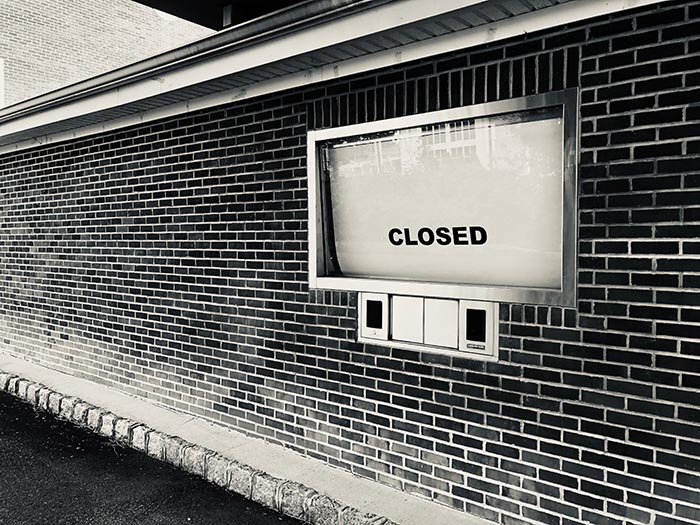Sponsored Content by Nationwide
Regional Bank Failures Shift Nationwide’s Underwriting Perspective

Although traditionally an underwriter of large institutions, Nationwide’s financial services practice sees the current uncertainty plaguing regional banks as a possible business opportunity. That being said, there is enough uncertainty in the banking environment these days to dictate a conservative approach.
When economic analysts look back on 2023, they’ll point to a series of small to midsize regional bank closures as a period of notable economic uncertainty.
During a five-day period, three banks collapsed for a variety of reasons — including overexposure to risky assets like cryptocurrency and concerns about liquidity — that led customers to rapidly withdraw their deposits. Federal Reserve economists warned that these failures could cause a mild recession in the latter half of 2023, CNN reported. Global bank stock prices declined, and the S&P Banks Select Industry Index was down more than 24% for the year as of May 19, 2023.
Many expressed concerns over the uninsured deposits — those over $250,000, which is past the FDIC’s insured limit — that made up a significant amount of funds at the banks that stumbled this spring.
Now, in May, the country is still seeing bank runs and closures and grappling with the ripple effects of this mini banking crisis. Closures of regional banks can make it difficult for startups and small businesses to get loans, curbing innovation and spending in an economy already rocked by inflation.
“I don’t think we’re at the end of this yet,” said Ryan Nava, vice president and financial institutions management liability D&O/E&O group leader with Nationwide.
Information — and Misinformation — Travels Faster Than Ever

Ryan Nava, Vice President and Financial Institutions Management Liability D&O/E&O Group Leader, Nationwide
One reason that small to midsize regional banks are suffering stressors is the rapid pace at which information, much of it misinformation, can spread on social media platforms and online. Historically, account holders weren’t able to rapidly access information and withdraw their deposits within a matter of minutes. Bank runs get their name from the fact that people literally had to run to the bank; now, people can withdraw their funds in seconds via online banking apps.
“If we were sitting in 1984 here, this couldn’t happen, because news took a little bit longer to disseminate,” Nava said.
The dynamic is exacerbated by the fact that, though information is disseminated quickly online, it is not always accurate. Account holders might see a rumor on social media that a bank is looking for a strategic partner or moving money into less risky asset classes, spurring a “crisis of confidence,” Nava said, that leads people to withdraw their deposits.
“It’s almost like an avalanche,” Nava said. “Now anybody with a phone really could just tweet it out and everything goes viral.”
This undermining of faith in banking systems might be based not in the institution’s actual practices but on online misinformation, differentiating today’s collapses from those of the past: “2008 was really caused by the banks taking out more risky assets and doing some things that maybe they shouldn’t have. Now, regulation has basically made them safer from a credit perspective. They have to hold more capital,” Nava said.
How Do Bank Closures Affect the Economy at Large?

Maria Fazzolari, Head of Professional & Specialty Claims, Nationwide
The Federal Reserve is taking actions to curb this crisis and restore confidence in the banking system. It created an emergency lending program, announced intentions to protect deposits over the $250,000 FDIC insurance limit and raised interest rates a quarter point in March in a continued attempt to curb inflation.
“The Fed stepped up and backstopped the deposits and basically solved the problem of the crisis of confidence, because we knew that deposits were going to be insured whether they were under or over that $250,000 limit,” Nava said.
While the banks’ depositors are all being made whole, the shareholders in these publicly-held banks have suffered as billions of dollars of market capitalization was eliminated as the sector was rocked by uncertainty.
“Shareholders have already brought numerous class actions alleging securities fraud against the banks, and their officers and directors,” said Maria Fazzolari, Head of Professional & Specialty Claims for Nationwide.
And these closures will continue to affect the economy in the coming months. Small to midsize financial institutions might see insurance rate increases as carriers adjust their underwriting approaches to take into account the effects of the current crisis. Banks were beginning to see a softening of insurance markets after rates hardened during COVID, and those trends might reverse this year.
Per Nava, few financial institutions face insurance renewals during the first quarter, so it’s unlikely we’ll see the full impact on rates until later in the year.
“I do wonder what the impact will be on the rate environment in the banking sector,” he said.
As regional banks face uncertainty on a number of fronts, they might tighten their lending and credit standards, leaving small businesses and startups without crucial funds as they wait for larger banks and other financial institutions to fill these gaps.
“Are the big banks going to step up and be more of a local lender?” Nava questioned. “It remains to be seen.”
Providing Insurance Solutions for Financial Institutions
Though they’ve historically worked with larger banks, Nationwide’s underwriters scrutinize a couple of key metrics that could help brokers looking to avoid major rate increases for their small to midsize banking insureds in the future. And they see a possible business opportunity in this period of transition.
“There are some key underwriting indicators that we can look to, to play in that space,” Nava said. “Those are the opportunities that we feel can provide solutions to our brokers.”
One metric underwriters might consider is whether banks have experienced rapid, unsustainable growth or have a large amount of uninsured deposits — two factors that contributed to bank closures earlier this year. “The percentage of uninsured deposits was a huge issue,” Nava said.
Another major consideration is whether banks are working in a number of different risky asset classes. Nava pointed to commercial real estate — which has struggled since the pandemic caused many employers to pivot to remote work — as one potentially concerning exposure that underwriters may scrutinize.
“If you have a bank that has a large exposure to loans in commercial real estate, in office and maybe retail, that’s a concern,” he said.
Institutions without these exposures might have an easier time finding policies without massive rate increases and may be able to avoid the pains of the hard market: “If you have a very simple, plain vanilla bank, there’s really no reason for a double-digit increase,” Nava said.
To learn more, visit: https://www.nationwide.com/business/insurance/management-liability-specialty/products/financial-institution-liability/.
About Nationwide
AM Best Rated A+ XV | S&P A+ | Fortune 100 Company
Products underwritten by Nationwide Mutual Insurance Company and Affiliated Companies. Not all Nationwide affiliated companies are mutual companies, and not all Nationwide members are insured by a mutual company. Home Office: One Nationwide Plaza, Columbus, OH. Nationwide, the Nationwide N and Eagle, and other marks displayed on this page are service marks of Nationwide Mutual Insurance Company, unless otherwise disclosed. © 2023 Nationwide Mutual Insurance Company.
This article was produced by the R&I Brand Studio, a unit of the advertising department of Risk & Insurance, in collaboration with Nationwide. The editorial staff of Risk & Insurance had no role in its preparation.










